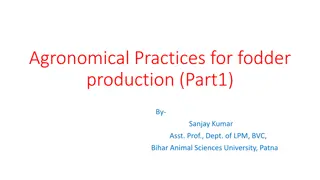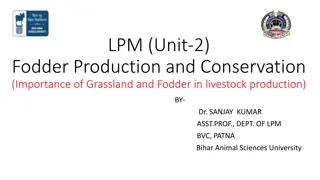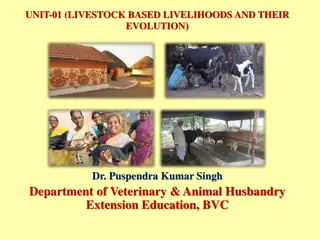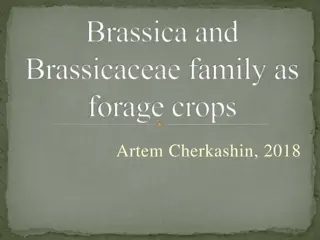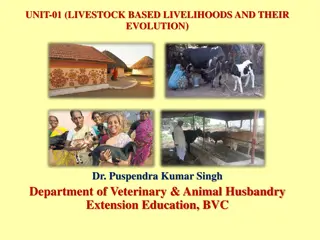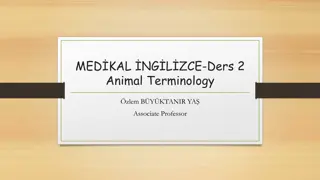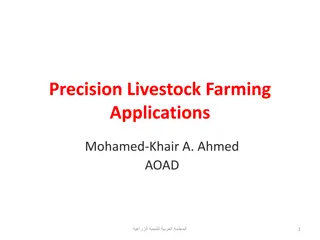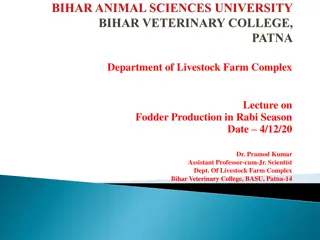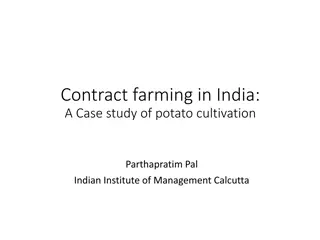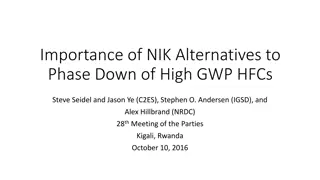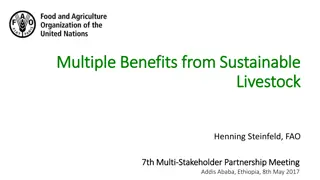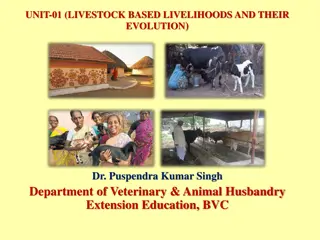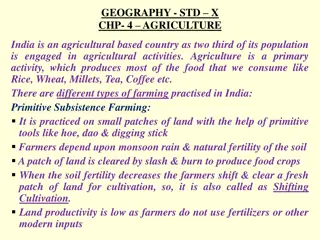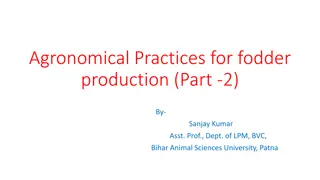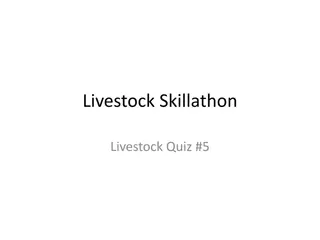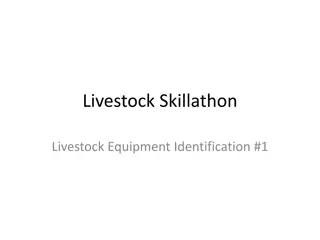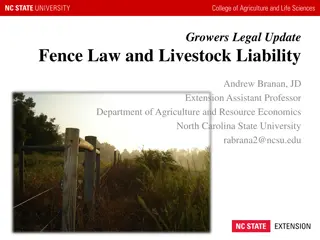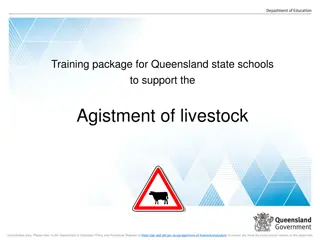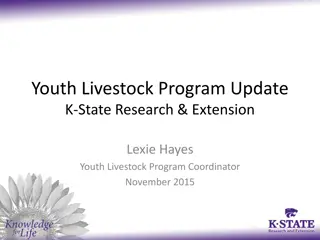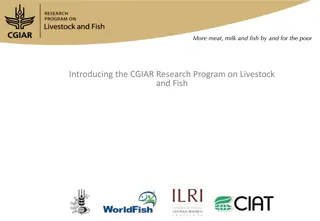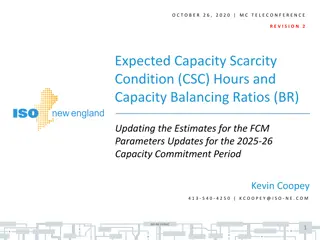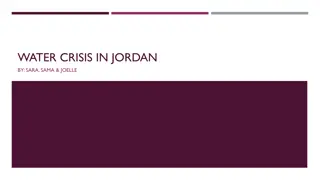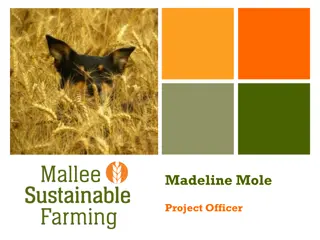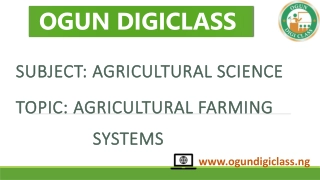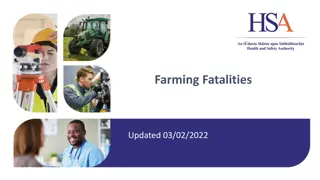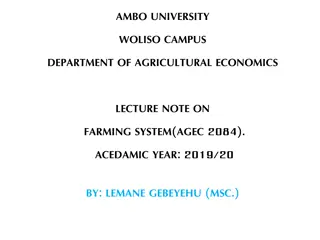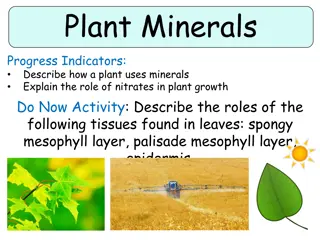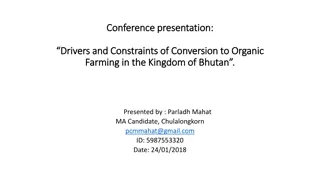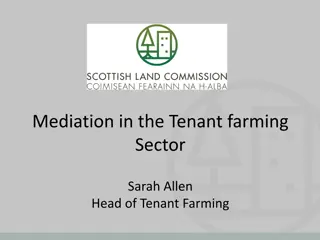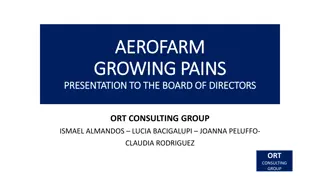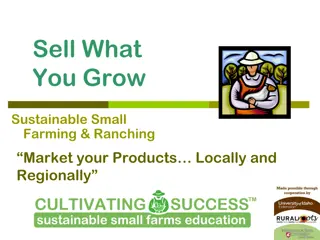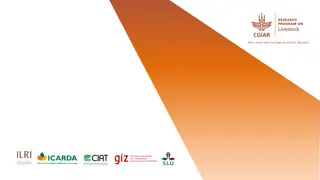Sustainable Alternatives for Fodder Scarcity in Indian Livestock Farming
Sheep and goat farming are vital for India's rural economy, but face challenges like feed scarcity. Grazing lands are depleting due to land use changes. Alternative solutions include conserving fodders, utilizing crop residues, and incorporating unconventional feeds. Sweet sorghum bagasse is a valuable feed resource with high biological value. Research aims to study the impact of concentrate supplementation on nutrient utilization in growing Nellore ram lambs fed sweet sorghum bagasse silage.
Uploaded on Sep 28, 2024 | 0 Views
Download Presentation

Please find below an Image/Link to download the presentation.
The content on the website is provided AS IS for your information and personal use only. It may not be sold, licensed, or shared on other websites without obtaining consent from the author. Download presentation by click this link. If you encounter any issues during the download, it is possible that the publisher has removed the file from their server.
E N D
Presentation Transcript
Dr.B.VIDYA ASSISTANT PROFESSOR DEPARTMRNT OF ANIMAL NUTRITION CVSc, KORUTLA
Introduction INDIA- Sheep and Goat play a vital role in rural economy Sheep - 75 million ( FAOSTAT ,2012) Goat - 160 million In India during the year 2011, total meat production from sheep and goat was 2,93,000 and 8,46,600 tonnes, respectively (FAOSTAT, 2013). 2nd International Conference on Animal & Dairy Sciences 9/17/2014 2
Contd.. Major constraints: - Shortage of feed and fodder Feed and Fodder Availability and Requirement in India Feed Requirement (mt) 123 1025 570 Availability (mt) 45 390 443 Shortfall (%) Concentrate Green Fodder Dry Fodder 63.41 61.95 22.28 9/17/2014 2nd International Conference on Animal & Dairy Sciences 3
Small ruminants in India mainly depend on grazing and browsing resources to meet their nutrient requirements. Now a days Continuous depletion of grazing land Grazing lands are converted to irrigated lands & SEZ of industries 9/17/2014 2nd International Conference on Animal & Dairy Sciences 4
Possible alternatives Conservation of fodders Utilization of crop residues Incorporation of unconventional feed stuffs (AIBP) 2nd International Conference on Animal & Dairy Sciences 9/17/2014 5
The potential uses of sweet sorghum for food, fiber, fertilizer, ethanol, and methane gas production Silage
Sweet Sorghum Bagasse Higher biological value Rich in micronutrients Used as feed and good for silage making (Rao et al. 2009). Sweet sorghum bagasse and stripped leaves provide a valuable, tradable feed resource (Bl mmel et al. 2009). 9/17/2014 2nd International Conference on Animal & Dairy Sciences 7
Objectives of Investigation To study the effect of supplementation of concentrate at different levels to SSB silage on nutrient utilization and N balance in growing Nellore ram lambs. 9/17/2014 2nd International Conference on Animal & Dairy Sciences 8
Materials and methods Procurement of bagasse: Decentralized crushing unit of Patancheru, Daulathabad, Medak district. ICRISAT, 9/17/2014 2nd International Conference on Animal & Dairy Sciences 9
Silage making Size of silo-12 LX9WX6H Moisture -60% Chopping length-1.5-2cm Additives Molasses- 1% Urea- 0.5% Salt 0.5% Incubation period: 30 days 9/17/2014 2nd International Conference on Animal & Dairy Sciences 10
Experimental design Growth trial cum metabolism trial Growth trial- 4 months Twenty eight Nellore ram lambs of 3-4 months old with an average body weight of 12-14 kg were divided in to 4 groups comprising 7 animals in each group/treatment. The following treatments were allotted at random to the 4 groups of Nellore ram lambs. 1. 2. 3. 4. Sole SSB silage feeding SSB Silage + concentrate @ 0.75 % of their live weight SSB Silage + concentrate @ 1% of their live weight SSB Silage + concentrate @ 1.25% of their live weight 9/17/2014 2nd International Conference on Animal & Dairy Sciences 11
Ingredient composition (g/kg) of concentrate mixture Name of the ingredient Concentrate mixture Maize grain 310.0 Ground nut cake 165.0 Sunflower cake 200.0 De oiled rice bran 230.0 Molasses 50.0 Urea 15.0 Mineral mixture 20.0 Salt 10.0 CP 17% and ME 10.6 MJ/kg DM 9/17/2014 2nd International Conference on Animal & Dairy Sciences 12
METABOLISM TRIAL: At the end of growth trial 16 ram lambs -4X4 Adaptation period : 5 days Collection period : 7 days Samples of offered feed, left over feed, faeces and urine samples was collected. Analysis of samples: proximate principles (AOAC, 1997) and fiber fraction (Van Soest et al. 1991). Urine was analyzed for nitrogen content (AOAC, 1997). 9/17/2014 2nd International Conference on Animal & Dairy Sciences 13
Results and Discussion Results and Discussion Chemical composition of experimental rations Proximate principle SSB silage Concentrate mixture Dry matter 34.83 89.50 Organic matter 92.46 88.31 Crude protein 7.48 17.27 Ether extract 1.99 3.45 Crude fibre 37.14 9.34 Nitrogen free extract 45.86 58.25 Total ash 7.53 11.68 9/17/2014 2nd International Conference on Animal & Dairy Sciences 14
Cell wall constituent SSB silage Concentrate mixture Neutral detergent fibre 71.81 32.05 Acid detergent fibre 46.75 13.32 Hemicellulose 25.06 18.73 Cellulose 31.16 7.09 Acid detergent lignin 9.05 3.11 9/17/2014 2nd International Conference on Animal & Dairy Sciences 15
Effect of feeding SSBLR silage supplemented with different levels of concentrate on dry matter intake in growing Nellore ram lambs Parameter R-I R-II R-III R-IV SEM Body weight (Kg) 13.5 b19.1a 20.2a 20.7a 0.80 Metabolic body weight (Kg) 7.02b 9.13a 9.51a 9.69a 0.29 Total DMI 343b 608a 700a 613a 41.1 9/17/2014 2nd International Conference on Animal & Dairy Sciences 16
Nutrient digestibility PARAMETER R-I R-II R-III R-IV SEM 53.42 1.10 55.53 2.21 56.31 1.68 58.44 1.26 Dry matter 0.86 Organic matter 55.63 1.73b 56.86 0.95 b 57.05 1.06 b 60.20 0.77a 0.62 Crude protein 62.81 1.02b 64.37 1.13ab 67.19 1.56ab 68.06 1.05a 0.75 Ether extract 71.93 2.10 74.72 1.38 78.12 1.56 78.27 2.24 0.63 Crude fibre 51.35 2.10 53.83 2.04 54.64 1.69 56.32 1.94 0.98 Nitrogen free 57.07 1.61b 62.66 1.40a 61.89 1.63a 64.68 1.48a 1.10 extract 9/17/2014 2nd International Conference on Animal & Dairy Sciences 17
Nutrient digestibility Cell wall constituents Neutral detergent 59.43 2.44 60.08 2.68 62.48 2.44 62.52 2.09 1.14 fibre Acid detergent 50.01 2.81 51.28 2.29 53.24 2.30 53.53 2.02 1.12 fibre Hemicellulose 60.62 1.66 62.03 1.62 65.40 2.07 66.07 2.52 1.07 Cellulose 51.23 2.16 52.49 1.89 55.82 1.32 55.95 1.91 0.98 9/17/2014 2nd International Conference on Animal & Dairy Sciences 18
Nitrogen balance PARAMETER R-I R-II R-III R-IV SEM N intake (g/d) 4.11 0.35b 9.66 0.55a 11.53 0.21a 11.26 0.98a 0.81 Faceal N (g/d) 1.38 0.23b 3.68 0.28a 3.46 0.45a 3.11 0.29a 0.27 Urinry N (g/d) 2.93 0.55 3.82 0.23 4.75 0.11 4.26 0.45 0.24 Total N loss (g/d) 4.31 0.42b 7.50 0.39a 8.21 0.49a 7.37 0.56a 0.44 N balance (g/d) -0.20 0.07c 2.16 0.49b 3.33 0.43ab 3.90 0.79a 0.57 9/17/2014 2nd International Conference on Animal & Dairy Sciences 19
CONCLUSION Sole SSBLR silage could not meet the protein and energy requirements. However, supplementation with concentrate mixture improved the digestibility and nitrogen balance in growing lambs. Recommended level of concentrate 1.25 % 9/17/2014 2nd International Conference on Animal & Dairy Sciences 20


